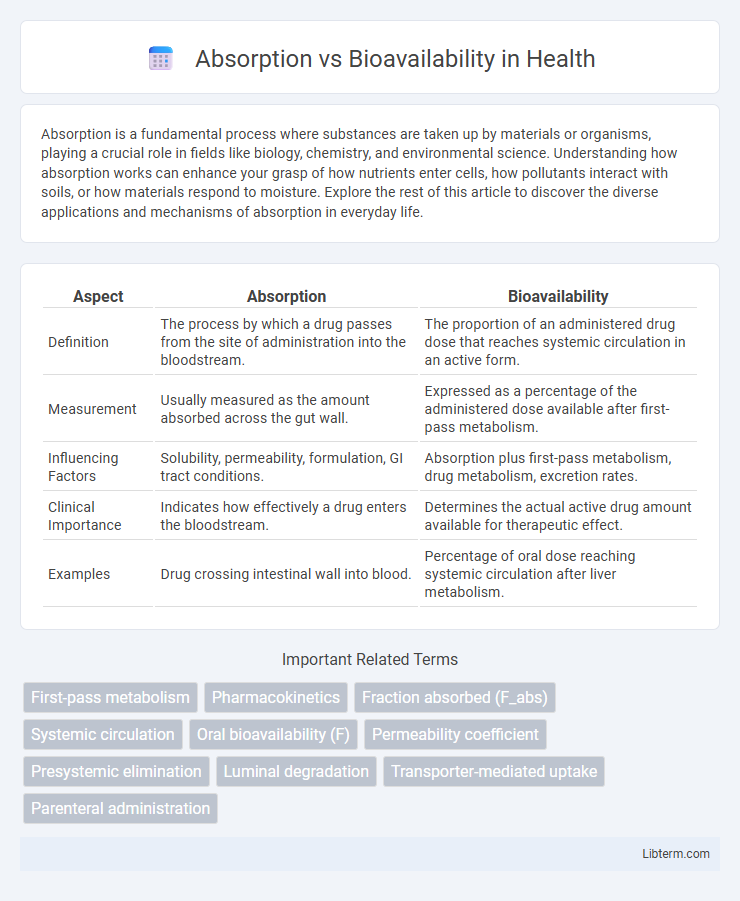Absorption is a fundamental process where substances are taken up by materials or organisms, playing a crucial role in fields like biology, chemistry, and environmental science. Understanding how absorption works can enhance your grasp of how nutrients enter cells, how pollutants interact with soils, or how materials respond to moisture. Explore the rest of this article to discover the diverse applications and mechanisms of absorption in everyday life.
Table of Comparison
| Aspect | Absorption | Bioavailability |
|---|---|---|
| Definition | The process by which a drug passes from the site of administration into the bloodstream. | The proportion of an administered drug dose that reaches systemic circulation in an active form. |
| Measurement | Usually measured as the amount absorbed across the gut wall. | Expressed as a percentage of the administered dose available after first-pass metabolism. |
| Influencing Factors | Solubility, permeability, formulation, GI tract conditions. | Absorption plus first-pass metabolism, drug metabolism, excretion rates. |
| Clinical Importance | Indicates how effectively a drug enters the bloodstream. | Determines the actual active drug amount available for therapeutic effect. |
| Examples | Drug crossing intestinal wall into blood. | Percentage of oral dose reaching systemic circulation after liver metabolism. |
Introduction to Absorption and Bioavailability
Absorption refers to the process by which a drug or nutrient passes from the site of administration into the bloodstream, primarily through the walls of the gastrointestinal tract. Bioavailability measures the proportion of the administered substance that reaches systemic circulation intact and is available for therapeutic effect. Understanding both absorption and bioavailability is crucial for determining the efficacy and appropriate dosage of pharmaceuticals and nutraceuticals.
Defining Absorption: What Happens in the Body
Absorption refers to the process by which nutrients or drugs pass from the site of administration into the bloodstream, primarily occurring in the gastrointestinal tract. This involves the dissolution of substances, permeation through the intestinal lining, and entry into systemic circulation. Effective absorption is crucial for ensuring adequate bioavailability, which measures the proportion of an administered dose that reaches systemic circulation in an active form.
Understanding Bioavailability: Key Concepts
Bioavailability refers to the proportion of a drug or nutrient that enters systemic circulation and is available for therapeutic or physiological effect after administration. Absorption involves the process by which substances pass through biological membranes, but high absorption does not guarantee high bioavailability due to factors like first-pass metabolism and solubility. Understanding bioavailability requires analyzing the interplay between absorption efficiency, metabolic transformation, and distribution to optimize drug formulation and nutrient delivery.
Absorption vs Bioavailability: Core Differences
Absorption refers to the process by which a drug or nutrient enters the bloodstream from the site of administration, while bioavailability measures the proportion of the active substance that reaches systemic circulation and is available for therapeutic effect. Key differences include that absorption accounts for initial uptake, whereas bioavailability encompasses absorption plus first-pass metabolism and other factors affecting active drug levels. Understanding these distinctions is essential for accurate dosing, drug development, and predicting therapeutic outcomes.
Factors Influencing Absorption Rates
Absorption rates are primarily influenced by factors such as drug solubility, gastrointestinal pH, and blood flow to the absorption site, which directly impact the rate at which a drug enters systemic circulation. The chemical nature of the drug, including lipid solubility and molecular size, affects its ability to pass through biological membranes, thereby altering bioavailability. Enzymatic activity and interactions with food or other drugs can also modulate absorption efficiency, ultimately influencing the overall bioavailability of the medication.
Determinants of Bioavailability in Nutrients and Drugs
Bioavailability is determined by factors such as solubility, chemical stability, absorption rate, and first-pass metabolism impacting the amount of nutrients or drugs reaching systemic circulation. The absorption process involves transport mechanisms across intestinal membranes, influenced by permeability and interaction with enzymes or transport proteins. Physiological conditions like gastrointestinal pH, motility, and presence of food or other substances further affect the effective bioavailability of nutrients and pharmaceuticals.
Common Misconceptions about Absorption and Bioavailability
Absorption refers to the process by which a drug passes from its site of administration into the bloodstream, while bioavailability measures the fraction of the administered dose that reaches systemic circulation intact. A common misconception is that complete absorption guarantees 100% bioavailability, ignoring factors like first-pass metabolism and drug degradation that reduce the active drug concentration. Understanding the distinction between absorption and bioavailability is crucial for accurate pharmacokinetic assessments and optimizing therapeutic efficacy.
How to Improve Absorption and Bioavailability
Improving absorption and bioavailability involves enhancing the solubility, permeability, and stability of a drug or nutrient. Techniques such as nanoparticle formulation, using liposomes, or adding absorption enhancers like piperine can significantly increase the amount of active compound that enters systemic circulation. Optimizing the drug's chemical properties and delivery method tailored to its pharmacokinetics can further maximize therapeutic efficacy.
Real-World Examples: Medications and Nutrients
Absorption refers to the process by which medications and nutrients enter the bloodstream from the gastrointestinal tract, while bioavailability measures the proportion of the active substance that reaches systemic circulation intact. For example, oral iron supplements show variable bioavailability due to factors like food interference and gastrointestinal pH, whereas intravenous iron provides 100% bioavailability bypassing absorption barriers. Similarly, the antibiotic amoxicillin has high oral absorption but its bioavailability can be reduced by stomach acid, whereas its bioavailability improves with certain formulations like extended-release tablets.
Conclusion: Absorption and Bioavailability in Health
Absorption refers to the process by which a nutrient or drug enters the bloodstream from the site of administration, while bioavailability measures the proportion of the substance that reaches systemic circulation intact and is available for therapeutic or nutritional effect. Optimizing both absorption and bioavailability is crucial for maximizing the efficacy of medications and dietary supplements in improving health outcomes. Understanding factors influencing these parameters helps in designing better drug formulations and nutritional interventions to enhance absorption rates and ensure higher bioavailability for effective treatment and preventive care.
Absorption Infographic

 libterm.com
libterm.com